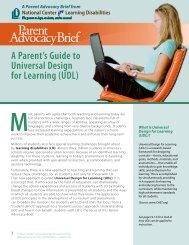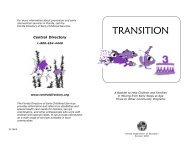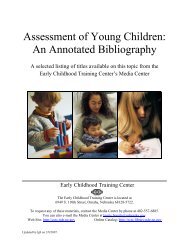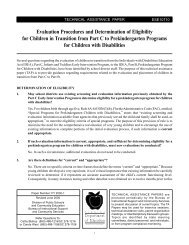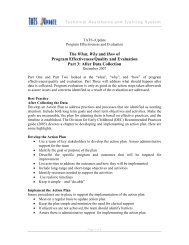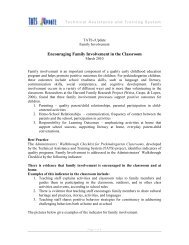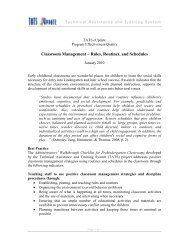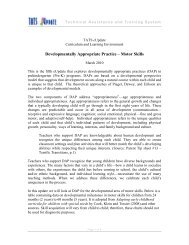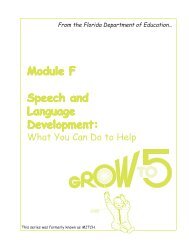Overview of the Battelle Developmental Inventory-2 - TATS
Overview of the Battelle Developmental Inventory-2 - TATS
Overview of the Battelle Developmental Inventory-2 - TATS
You also want an ePaper? Increase the reach of your titles
YUMPU automatically turns print PDFs into web optimized ePapers that Google loves.
Technical Assistance and Training System<br />
<strong>TATS</strong> eUpdate<br />
Evaluation and Assessment <strong>of</strong> Young Children<br />
<strong>Overview</strong> <strong>of</strong> <strong>the</strong> <strong>Battelle</strong> <strong>Developmental</strong> <strong>Inventory</strong>-2<br />
May 2009<br />
The Florida Department <strong>of</strong> Education (FDOE), in collaboration with <strong>the</strong> Early Steps<br />
Program, Children's Medical Services (CMS) Network, Florida Department <strong>of</strong> Health<br />
(DOH), has initiated <strong>the</strong> use <strong>of</strong> <strong>the</strong> <strong>Battelle</strong> <strong>Developmental</strong> <strong>Inventory</strong> 2 nd Edition (BDI-2)<br />
to collect data on children across both <strong>the</strong> Early Steps Program Part C, and <strong>the</strong><br />
prekindergarten Exceptional Student Education (ESE) Section 619 programs. This data<br />
will be used to report on <strong>the</strong> progress <strong>of</strong> infants, toddlers, and preschool children with<br />
disabilities served in <strong>the</strong> Early Steps Part C programs and/or served in Pre-K ESE<br />
programs Section 619 for State Performance Plan (SPP) Indicator 7. There are three<br />
points that children may be assessed: at entry into Part C/Early Steps; at exit from Part<br />
C/Early Steps which may also be <strong>the</strong> entrance for <strong>the</strong> Prekindergarten Program for<br />
Children with Disabilities (Part B Section 619); and at exit from <strong>the</strong> Preschool Special<br />
Education Program Prekindergarten Program for Children with Disabilities (Part B<br />
Section 619). Some school districts and local Early Steps already use this tool, but as part<br />
<strong>of</strong> Florida’s effort to address <strong>the</strong> indicator, all appropriate school district and Early Steps<br />
personnel will be trained in <strong>the</strong> use <strong>of</strong> <strong>the</strong> BDI-2 by spring <strong>of</strong> 2009.<br />
Under certain circumstances, <strong>the</strong> results <strong>of</strong> <strong>the</strong> BDI-2 Screening Test may be reported in<br />
place <strong>of</strong> <strong>the</strong> full BDI-2 assessment to fulfill <strong>the</strong> requirements <strong>of</strong> <strong>the</strong> child outcome<br />
measurement system for Indicator 7 <strong>of</strong> <strong>the</strong> SPP. If <strong>the</strong> only suspected disability is a<br />
speech disorder (e.g., articulation, voice, or fluency disorders), <strong>the</strong> BDI-2 Screening<br />
Test may be administered in place <strong>of</strong> <strong>the</strong> full assessment. The child must score in <strong>the</strong><br />
typical range <strong>of</strong> development (>-1.5 SD) in all domains for <strong>the</strong> screener to be used. A<br />
detailed description <strong>of</strong> <strong>the</strong> appropriate use <strong>of</strong> <strong>the</strong> BDI-2 Screening Test can be found in<br />
<strong>the</strong> July 14, 2008 Joint memorandum from <strong>the</strong> Early Steps State Office and <strong>the</strong> Bureau <strong>of</strong><br />
Exceptional Education and Student Services (BEESS): Use <strong>of</strong> <strong>the</strong> BDI-2 Screening Test<br />
in Florida’s Child Outcomes Measurement System.<br />
The purpose <strong>of</strong> this eUpdate is to provide information related to <strong>the</strong> full BDI-2<br />
assessment. More detailed information can be found in <strong>the</strong> Examiner’s Manual.<br />
The BDI-2 Instrument<br />
The BDI-2 is a “standardized, individually administered assessment battery <strong>of</strong> key<br />
developmental skills in children from birth through 7 years <strong>of</strong> age” (<strong>Battelle</strong><br />
Page 1 <strong>of</strong> 6
Technical Assistance and Training System<br />
Development <strong>Inventory</strong> – Examiner’s Manual, p. 1). It involves observations <strong>of</strong> <strong>the</strong> child,<br />
parent and/or caregiver interviews, and interactions with <strong>the</strong> child using toys, games and<br />
tasks. During sessions with <strong>the</strong> child, <strong>the</strong> examiner(s) observes <strong>the</strong> child’s ability to<br />
follow directions, interact, and perform selected tasks. Areas that cannot be assessed<br />
during test sessions may be supplemented with parent information. The child’s<br />
performance is scored based on standardized criteria using a simple three point scoring<br />
system.<br />
The BDI-2 looks at developmental milestones. It is generally accepted that child<br />
development occurs in a particular sequence - <strong>the</strong> attainment <strong>of</strong> one skill typically<br />
depends on <strong>the</strong> acquisition and mastery <strong>of</strong> preceding skills. From an identified list <strong>of</strong> over<br />
4,000 skills that appear in typically developing children, <strong>the</strong> designers <strong>of</strong> <strong>the</strong> BDI-2 chose<br />
450 test items placed into five domains:<br />
(1) Adaptive<br />
(2) Personal-Social<br />
(3) Communication<br />
(4) Motor<br />
(5) Cognitive<br />
The skills which comprise <strong>the</strong> 450 test items were chosen because <strong>the</strong>y were identified<br />
though research as ones critical to <strong>the</strong> development <strong>of</strong> functional life skills and could be<br />
impacted by educational intervention.<br />
The information gained from <strong>the</strong> administration <strong>of</strong> <strong>the</strong> BDI-2, can assist in:<br />
1. Identifying strengths in developmental skills and opportunities for learning for<br />
typically developing children and children with disabilities<br />
2. Assessing children considered to be at risk in any developmental area<br />
3. Development <strong>of</strong> Individual Family Support Plans (IFSP) and Individual<br />
Educational Plans (IEP)<br />
4. Monitoring student progress toward long and short term goals and objectives<br />
(<strong>Battelle</strong> Development <strong>Inventory</strong> – Examiner’s Manual, p.7-8)<br />
Qualifications for Administering <strong>the</strong> Instrument<br />
When administering an assessment, <strong>the</strong> knowledge, skills, and experience <strong>of</strong> <strong>the</strong><br />
evaluator are an important part <strong>of</strong> <strong>the</strong> validity <strong>of</strong> <strong>the</strong> test and interpretation <strong>of</strong> results. In<br />
o<strong>the</strong>r words, in order to obtain accurate results, <strong>the</strong> examiner needs to understand <strong>the</strong> test<br />
well and should have a good understanding <strong>of</strong> typical and atypical child development.<br />
The examiner must also understand and be comfortable with <strong>the</strong> age level <strong>of</strong> <strong>the</strong> child<br />
being assessed. “It is essential that examiners have appropriate training and experience<br />
working with <strong>the</strong> children <strong>of</strong> <strong>the</strong> age <strong>the</strong>y will assess as well as comfort level that allows<br />
for easy interaction with <strong>the</strong>m” (<strong>Battelle</strong> Development <strong>Inventory</strong> – Examiner’s Manual,<br />
p. 10). If a young child with special needs is being evaluated, <strong>the</strong> examiner also should<br />
Page 2 <strong>of</strong> 6
Technical Assistance and Training System<br />
have sufficient knowledge <strong>of</strong> <strong>the</strong> disability and ways to provide appropriate<br />
accommodations without compromising <strong>the</strong> results <strong>of</strong> <strong>the</strong> assessment.<br />
The following description <strong>of</strong> qualifications for evaluators using <strong>the</strong> BDI-2, is from <strong>the</strong><br />
<strong>Battelle</strong> <strong>Developmental</strong> <strong>Inventory</strong> – 2 nd Edition, Examiner’s Manual, page 10.<br />
Preschool, kindergarten and primary school teachers, special<br />
educators, and infant intervention providers are <strong>the</strong> primary user<br />
groups for <strong>the</strong> BDI-2. Related services providers, such as speechlanguage<br />
pathologists, adaptive physical education specialist,<br />
psychologist, and diagnosticians are also likely to use <strong>the</strong> BDI-2 to<br />
measure <strong>the</strong> functional abilities <strong>of</strong> young children. Educational aides<br />
who have considerable experience working with <strong>the</strong> children being<br />
assessed may appropriately use <strong>the</strong> BDI-2 or parts <strong>of</strong> it if <strong>the</strong>y have<br />
received comprehensive training in its administration and<br />
demonstrated pr<strong>of</strong>iciency in its use through supervised practice with<br />
<strong>the</strong> instrument.<br />
The BDI-2 and Diverse Learners<br />
Use <strong>of</strong> <strong>the</strong> BDI-2 with diverse learners is addressed in detail in <strong>the</strong> Examiner’s Manual.<br />
In addition to having appropriate knowledge and skills related to <strong>the</strong><br />
use <strong>of</strong> <strong>the</strong> BDI-2, examiners are obligated to determine, to <strong>the</strong> extent<br />
possible, characteristics <strong>of</strong> <strong>the</strong> child that may influence <strong>the</strong><br />
administration <strong>of</strong> <strong>the</strong> instrument and <strong>the</strong> interpretation <strong>of</strong> <strong>the</strong> results. Of<br />
particular importance are <strong>the</strong> child’s native language and <strong>the</strong> presence<br />
<strong>of</strong> suspected disabilities. (<strong>Battelle</strong> Development <strong>Inventory</strong> –<br />
Examiner’s Manual, p. 11)<br />
Any special circumstance used to administer <strong>the</strong> BDI-2 assessment should be<br />
documented and included in <strong>the</strong> final report.<br />
Cultural and English Language Learners (ELL) Considerations<br />
The Examiner’s Manual recommends that <strong>the</strong> cultural and linguistic background <strong>of</strong> a<br />
child be considered in order to determine if <strong>the</strong> scores truly represent <strong>the</strong> developmental<br />
ability <strong>of</strong> <strong>the</strong> child. If <strong>the</strong> child is not familiar with <strong>the</strong> culture <strong>of</strong> <strong>the</strong> United States or with<br />
specific regional cultures (Nor<strong>the</strong>ast, Sou<strong>the</strong>ast, Midwest, etc.), caution should be<br />
exercised when interpreting results. The BDI-2 is <strong>of</strong>fered in both English and Spanish<br />
versions. The manual <strong>of</strong>fers <strong>the</strong>se cautions when <strong>the</strong> test is administered to a child whose<br />
first language is not English.<br />
Assessing a child whose first language is not English raises a concern<br />
when administration requires oral instructions, because <strong>the</strong> child may<br />
not comprehend what he or she is being asked to do. In such<br />
circumstances, test results many not accurately reflect <strong>the</strong> behaviors<br />
Page 3 <strong>of</strong> 6
Technical Assistance and Training System<br />
that <strong>the</strong> test intended to measure nor <strong>the</strong> actual abilities and skills <strong>of</strong> <strong>the</strong><br />
child. Parents <strong>of</strong> caregivers also may be limited in <strong>the</strong>ir understanding<br />
<strong>of</strong> English and in <strong>the</strong>ir ability to fully describe <strong>the</strong> child’s abilities and<br />
behaviors. (<strong>Battelle</strong> Development <strong>Inventory</strong> – Examiner’s Manual, p.<br />
11)<br />
If <strong>the</strong> examiner does not believe that a score obtained for a child who is an English<br />
language learner is valid, <strong>the</strong>n <strong>the</strong> score for that particular domain should not be<br />
submitted for accountability purposes and noted in <strong>the</strong> final report.<br />
Children with Disabilities:<br />
General accommodation strategies for children with disabilities are discussed in <strong>the</strong><br />
Examiner’s Manual. However, evaluators must use clinical judgment when deciding<br />
which strategies are appropriate for each individual child. Evaluators must know <strong>the</strong><br />
child’s skills and abilities, as well as ways to optimize <strong>the</strong> child’s performance.<br />
Additionally, evaluators must “determine <strong>the</strong> construct being measured by a test item”<br />
(<strong>Battelle</strong> Development <strong>Inventory</strong> – Examiner’s Manual, p.12) to be sure that <strong>the</strong><br />
accommodation does not compromise <strong>the</strong> integrity <strong>of</strong> <strong>the</strong> assessment construct. Also, one<br />
accommodation may not be appropriate for all children with <strong>the</strong> same disability. When in<br />
doubt, it is recommended that evaluators consult with a specialist in <strong>the</strong> child’s area <strong>of</strong><br />
disability or with o<strong>the</strong>rs who are knowledgeable about <strong>the</strong> use <strong>of</strong> accommodations during<br />
formal assessments.<br />
Reflections:<br />
1. What is <strong>the</strong> process in your district or program to take into account cultural factors<br />
when interpreting results on <strong>the</strong> BDI-2?<br />
2. Do you know <strong>the</strong> administration adaptations <strong>of</strong> <strong>the</strong> BDI-2 for children who have<br />
disabilities?<br />
Great teachers empathize with kids, respect <strong>the</strong>m, and believe that each one has<br />
something special that can be built upon. – Ann Lieberman<br />
References and Resources<br />
Bliss, S. (2007). Test Reviews: Newborg, J. (2005) <strong>Battelle</strong> <strong>Developmental</strong> <strong>Inventory</strong>,<br />
Second Edition, Itasca, IL: Riverside Publishing. Journal <strong>of</strong> Psychoeducational<br />
Assessment 25(4), 409-415.<br />
Division for Early Childhood (DEC). (2007). Promoting positive outcomes for children<br />
with disabilities: Recommendations for curriculum, assessment, and program<br />
evaluation. Missoula, MT: Author.<br />
Page 4 <strong>of</strong> 6
Technical Assistance and Training System<br />
Early Childhood Outcomes (ECO) Center<br />
A collaborative project funded by OSEP providing research and technical assistance to<br />
promote <strong>the</strong> development and implementation <strong>of</strong> child and family outcome measures for<br />
infants, toddlers, and preschoolers with disabilities for use in local, state, and national<br />
accountability systems. http://www.fpg.unc.edu/~eco/index.cfm<br />
Epstein, A. S., Schweinhart, L. J., DeBruin-Parecki, A., & Robin, K. B. Preschool<br />
assessment: A guide to developing a balanced approach. Fact sheet from <strong>the</strong><br />
National Institute for Early Education Research. Retrieved June 9, 2008, from<br />
http://nieer.org/resources/factsheets/12.pdf<br />
Florida Rule 6A-6.03026 Florida Administrative Code (FAC) Special Programs for<br />
Prekindergarten Children with Disabilities and 6A-6.03027 (FAC) Special<br />
Programs for Children Three Through Five Years Old Who are <strong>Developmental</strong>ly<br />
Delayed.<br />
https://www.flrules.org/gateway/readFile.asp?sid=0&tid=1062846&type=1&file=<br />
6A-6.03026.doc<br />
https://www.flrules.org/gateway/readFile.asp?sid=0&tid=1062943&type=1&file=<br />
6A-6.03027.doc<br />
Newborg, J. (2005). <strong>Battelle</strong> <strong>Developmental</strong> <strong>Inventory</strong>, Second Edition. Itasca, IL:<br />
Riverside Publishing.<br />
Newborg, J. (2005). <strong>Battelle</strong> <strong>Developmental</strong> <strong>Inventory</strong>, Second Edition Screening Test.<br />
Itasca, IL: Riverside Publishing.<br />
Screening and Assessment <strong>of</strong> Young English-Language Learners (2005). Supplement to<br />
<strong>the</strong> NAEYC position statement on early childhood curriculum, assessment, and<br />
program evaluation. National Association for <strong>the</strong> Education <strong>of</strong> Young Children.<br />
SERVE<br />
The SERVE Center is one <strong>of</strong> ten Laboratories providing research-based information and<br />
services nationwide. These Laboratories form a nationwide education knowledge<br />
network, building a bank <strong>of</strong> information and resources shared and disseminated<br />
nationally and regionally to improve student achievement. Resources and information are<br />
available on a variety <strong>of</strong> topics for Pre-K programs, including transition, early literacy,<br />
and evaluation and assessment. http://www.serve.org/<br />
Shaw, E., Goode, S, Ringwalt, S., & Ayankoya, B. (2005). Minibibliography: Early<br />
identification <strong>of</strong> culturally and linguistically diverse children (Aged 0-5).<br />
NECTAC Clearinghouse on Early Intervention and Special Education.<br />
Retrieved June 10, 2008 from http://www.nectac.org/~pdfs/pubs/earlyidmini.pdf<br />
Page 5 <strong>of</strong> 6
Technical Assistance and Training System<br />
Technical Assistance & Training System (<strong>TATS</strong>)<br />
Statewide project providing technical assistance and training to programs in Florida<br />
serving prekindergarten children with disabilities. Website provides information and<br />
resources on curriculum and instruction, evaluation and assessment, family involvement,<br />
inclusion, program effectiveness/quality, and transition, as well as, linking early<br />
childhood partners. www.tats.ucf.edu<br />
<strong>TATS</strong> eUpdates are a service <strong>of</strong> <strong>the</strong> Technical Assistance & Training System Communities <strong>of</strong> Practice. The<br />
<strong>TATS</strong> eUpdates are intended to provide current information related to best practices or trends in <strong>the</strong><br />
education <strong>of</strong> young children with special needs in <strong>the</strong> areas <strong>of</strong> Transition, Program Effectiveness,<br />
Inclusion, Curriculum & Instruction, Evaluation & Assessment, and Family Involvement. For more<br />
information about <strong>the</strong> <strong>TATS</strong> Communities <strong>of</strong> Practices and <strong>the</strong> <strong>TATS</strong> eUpdates, please log on to<br />
www.tats.ucf.edu.<br />
Page 6 <strong>of</strong> 6





